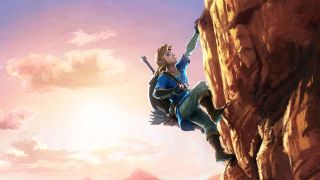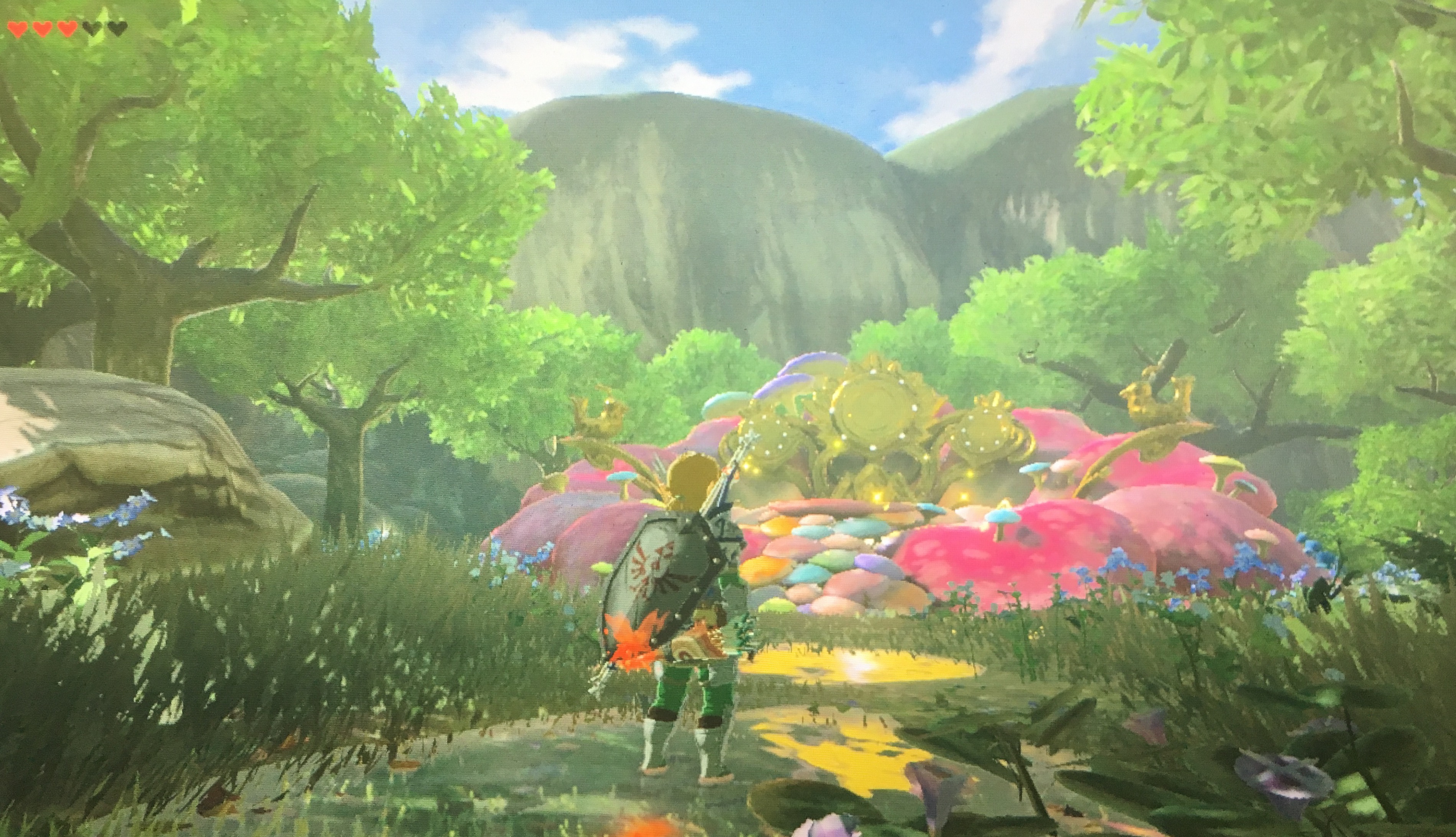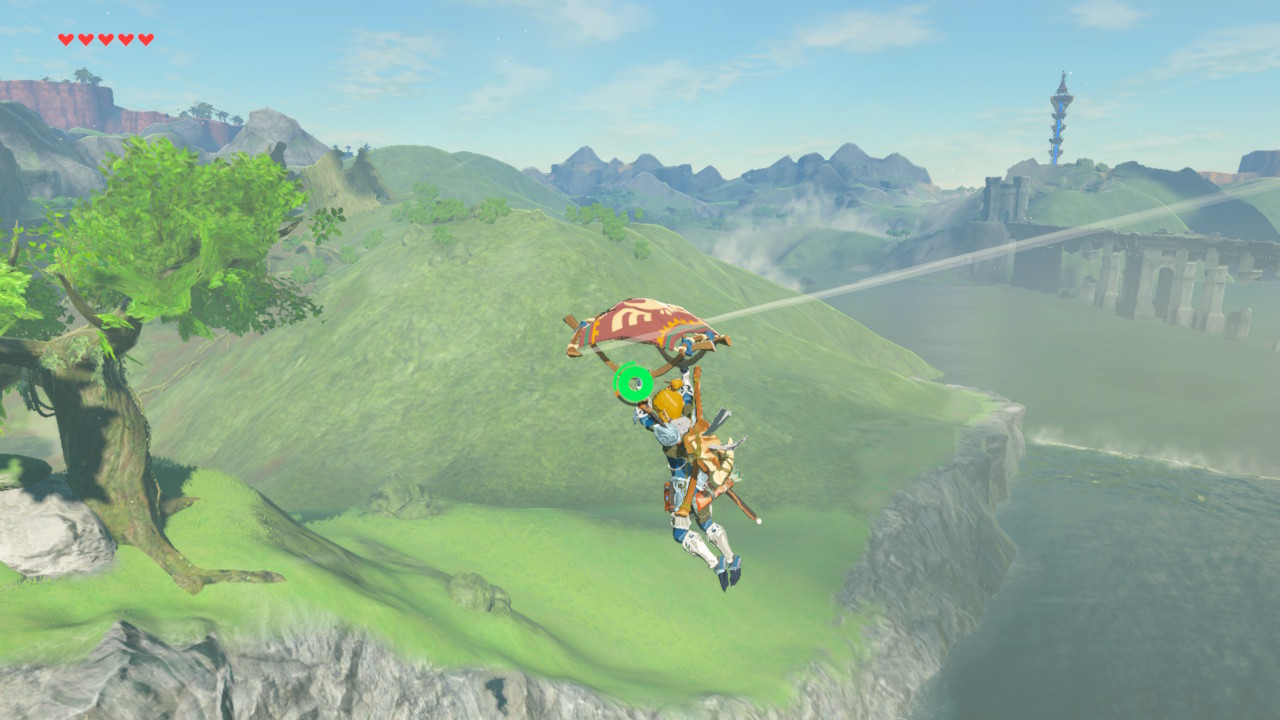Breath of the Wild Breath of the Wild Climbing Art
Zelda: Breath of the Wild'southward climbing is the hole-and-corner ingredient that finally adds existent adventure to open-world gaming

"Oh, climbing, cool", I idea, when I first found out about the new vertical versatility of The Legend of Zelda: Breath of the Wild. "That'll mean a few new hidden things and less faff dealing with walls". And then I went back almost my usual business organization of ogling seemingly more exciting things, like the bigger than standard open-earth, and the evidently more freeform game structure. I suspect a lot of us did the same. Becauseclimbing, correct? Information technology's not exactly a new thing in activity games, and it was hardly going to be the centrepiece of something as specific and circuitous – withal traditionally rigid - every bit a Zelda game.
Turns out I was all kinds of wrong nearly that. And thank God I was.

Considering Breath of the Wild isn't merely a bigger, shiner Zelda with a few new tricks. It's a radical, wonderful, incessantly heed-boggling reworking of Nintendo'south 31 year-sometime fantasy take chances concept. The ironic thing about Zelda is that equally the years had gone on, and the cadre format became increasingly standardised, it turned into an adventure series without the adventure. An excellent action/puzzle series, but ones whose formula for the overall journeying became so tried and truthful equally to veto the potential for much exploration, discovery, or many genuine surprises.
Jiff of the Wild is the reverse of that. Having sunk a week into it now, information technology'south in hindsight very apparent indeed that the visual similarity betwixt the game's opening vista and the beginning Zelda'southward original NES box art is no coincidence. With its unfathomably vast scale, entirely freeform structure, 'Go anywhere, do anything' philosophy, and constantly unfurling, player-led reveals of new sights, new places, and new ways of interpreting its globe, The Fable of Zelda: Breath of the Wild feels similar every fleck the intentional realisation of that at-the-time-impossible 1986 hope. And the more I play it, the more than I realise that it couldn't accept achieved any of that without the climbing.
Breath of the Wild's exploration – and thus, the entire essence of the game congenital around information technology – is utterly different to non merely that in any other Zelda game, just also that in whatsoever other open-earth game effectually. While yous tin can go off-road and detect secrets and oddities in Grand Theft Auto, its worlds are divers by the fact that there are roads in the kickoff identify, defined, rigid, suggested routes wrapped around an approximation of the existent world with all its civilised trappings. The Witcher 3's equus caballus travel and rudimentary mantling gives you freedom to go pretty much wherever you want, but in order to remain navigable past those relatively mundane means, its topography stays relatively, naturalistically straightforward. Far Cry and Skyrim have hills and mountains galore, simply these are again designed for slow, realistic, restrictive rise, glitchy horse-exploits aside.

These interplays between game systems and the kind of traversal they allow define the shapes of their worlds, and thus the kinds of emotional experiences they tin can deliver through the exploration of those worlds. All work very well within their own context, but Jiff of the Wild wants to create something very different. Breath of the Wild, with its minimal guidance, experimental, player-driven gameplay sandbox, and overall air of 'Annihilation tin can happen' wants to create a real, amplified sense of pure hazard into the unknown.
It wants its every journey to exist punctuated by a constant stream of freeform discoveries, in order to deliver the pure essence of exploration in an exaggerated, constantly exciting grade. And it understands that to do this, it has to make the actor every bit self-reliant equally possible, reducing and removing as much of the guidance, auto-mapping, and sense of prophylactic-by-icon-overload that typifies most modern open-worlders. Information technology's a game almost fending for yourself, finding your own approach to everything you do, and making the unabridged journey your own. And it could not deliver whatever of that in the way that it does without the climbing organization.
Its inclusion has 3 key effects. Firstly, it allows for the creation of an farthermost only accessible verticality far in excess of that presented by well-nigh games in the genre, which in turn allows Breath of the Wild to orchestrate endless moments of discovery and invitation through newly-earned viewpoints. Secondly, it facilitates navigation via in-game orienteering, the immense heights from which the thespian can banquet their eyes on immense describe-distances – filled as they are with detailed and highly specific topography – thus allowing frequent opportunities to survey the journey from within, plan and re-plan routes, and improvise detours on instinct without e'er having to break abroad to a map screen.

And thirdly, and just every bit importantly, it crafts an intimate attachment to the fabric of the world itself, the ability and requirement to literally go hands-on calculation an extra-personal interest to each journey and discovery y'all make. Where the mountains in The Elder Scrolls are largely used as barriers to finish the actor from taking certain routes, funnelling them into developer-favoured paths and areas, Breath of the Wild does the opposite. Every mountain is an invitation. "Come up upwardly here", it says. "Come up and see what you can discover. Come and see where this leads". And yous will detect something, and you will detect somewhere new to go, and it will all feel like yours, because of the careful interplay of Zelda'south micro-systems.
The sense of personal accomplishment wouldn't be half as great if climbing a surface was always a straightforward, sure thing. Merely the limited stamina judge, and the clever design of hills, rocks and cliffs to include numerous, carefully hidden ledges and residue points, turns each ascension into a complimentary-course puzzle, and makes the unassailable a mere foil for your bravery and creativity.
And then there's the paraglider. The crowning reward for your first hour(due south) spent learning the ropes through hardship, trial, and multiple, painful errors on the Plateau, its first proper utilise – as y'all descend through the heaven to Hyrule proper, and gain your start real impression of the vastness of the world you have to explore – is a fantastic moment of catharsis and excitement. Just by tying exploration so much to verticality and line-of-sight – thus making surveyance of distant terrain and subsequent flight toward it fundamental - Nintendo ensures that every journey later that point starts, or is regularly punctuated with, this same essence.

Where other games volition permit you spot a potential route and and then brainstorm steadily making your mode along it, with frequent checks of the map to ensure you're going the right mode, Zelda lets y'all discover something heady in the distance and then launch yourself toward information technology, the time betwixt discovery and activity minimised. The system delivers both scale and immediacy, condensing the potential-to-realisation procedure with great spontaneity and swift emotional pay-off. Coupled with the intricate care required to meridian many of Zelda'due south abundant summits, the pacing of this perpetual effort/advantage arrangement maintains a fantastic sense of momentum and fun, even as you traverse many miles of open countryside in lodge to attain a (deliberately) distant objective. Thus, Jiff creates a world not only to be played in, simply to exist played with, a place that isn't a backdrop to your take a chance, but which provides its very physical and emotional make-up.
The process of overhauling everything we know well-nigh a series with one new, fundamental game system is hardly a new philosophy for Nintendo. The history of its franchises is, of course, a history of radical reinterpretation on a game-by-game ground. But by steering so hard in that direction this time, with such pure focus and intent on fun and 18-carat freedom of discovery, it has ensured that Jiff of the Wild finally instills the open-world genre with the real sense of hazard it has always aspired to only never truly achieved.
Source: https://www.gamesradar.com/the-legend-of-zelda-breath-of-the-wilds-climbing-is-the-secret-ingredient-that-finally-adds-real-adventure-to-open-world-gaming/

0 Response to "Breath of the Wild Breath of the Wild Climbing Art"
ارسال یک نظر